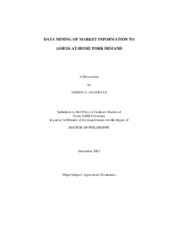| dc.description.abstract | This study analyzes the economic and demographic patterns of at-home pork consumption for representative individuals over 18 years of age in the United States. Three data sets purchased by the National Pork Board (NPB) are mined for this purpose: (1) National Eating Trends (NET) data from National Panel Diary (NPD) on individuals' intake and their demographic characteristics; (2) weekly retail prices for fresh meats and fresh pork cuts from FreshLook; and (3) weekly retail prices for processed pork products from A.C. Nielsen.
Heckman sample selection models are used to find demographic, health, and attitudinal/lifestyle patterns of consumption of twelve fresh and processed pork products as well as beef, chicken, and seafood. In the fall, individuals have a higher probability of eating beef, chicken, pork tenderloin, and bacon, but a lower probability of eating fresh seafood, canned ham, and smoked ham relative to the spring. The New England region has the highest likelihood of eating fresh pork, beef, chicken, seafood, pork roasts, pork tenderloin, and pork hotdogs. Blacks, on average, eat more fresh and processed pork, chicken, pork sausage, bacon, and canned ham, but less beef relative to whites. Concern about serving food with fat is negatively related with the likelihood of eating processed pork, lunchmeat, ham, and bacon, but it is positively related with the likelihood of eating pork hotdogs.
A three-stage selectivity-adjusted censored LA/AIDS model is developed and estimated to find demand-price relationships for: (1) fresh meats (pork, beef, chicken, and seafood) and (2) nine fresh and processed pork cuts. However, aggregate fresh meats are substitutes for each other in at-home market, but there are substantial complementarities between pork cuts. Pork sausage is the major competitor for the processed products, pork roasts and pork tenderloin, but a major complement for pork ribs. There is relatively week substitutability between pork and beef, and relatively strong substitutability between pork and chicken and between beef and chicken. This could suggest opportunities for some joint marketing efforts between pork and beef commodity interests.
This information can be used as a guide for marketing strategists for targeting and promotion as well as for category management of the disaggregated pork products. | en |


